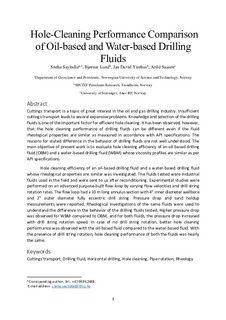Hole-cleaning performance comparison of oil-based and water-based drilling fluids
Journal article
Submitted version
Permanent lenke
http://hdl.handle.net/11250/2468626Utgivelsesdato
2017Metadata
Vis full innførselSamlinger
Originalversjon
Journal of Petroleum Science and Engineering. 2017, 159 49-57. 10.1016/j.petrol.2017.08.069Sammendrag
Cuttings transport is a topic of great interest in the oil and gas drilling industry. Insufficient cuttings transport leads to several expensive problems. Knowledge and selection of the drilling fluids is one of the important factor for efficient hole cleaning. It has been observed, however, that the hole cleaning performance of drilling fluids can be different even if the fluid rheological properties are similar as measured in accordance with API specifications. The reasons for stated difference in the behavior of drilling fluids are not well understood. The main objective of present work is to evaluate hole cleaning efficiency of an oil-based drilling fluid (OBM) and a water-based drilling fluid (WBM) whose viscosity profiles are similar as per API specifications.
Hole cleaning efficiency of an oil-based drilling fluid and a water-based drilling fluid whose viscosity profiles are similar was investigated. The fluids tested were industrial fluids used in the field and were sent to us after reconditioning. Experimental studies were performed on an advanced purpose-built flow-loop by varying flow velocities and drill string rotation rates. The flow loop had a 10 m long annulus section with 4″ inner diameter wellbore and 2″ outer diameter fully eccentric drill string. Pressure drop and sand holdup measurements were reported. Rheological investigations of the same fluids were used to understand the difference in the behavior of the drilling fluids tested. Higher pressure drop was observed for WBM compared to OBM, and for both fluids, the pressure drop increased with drill string rotation speed. In case of no drill string rotation, better hole cleaning performance was observed with the oil-based fluid compared to the water-based fluid. With the presence of drill string rotation, hole cleaning performance of both the fluids was nearly the same.
